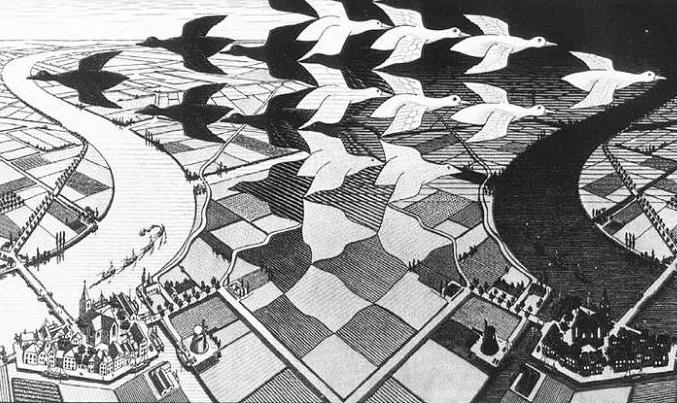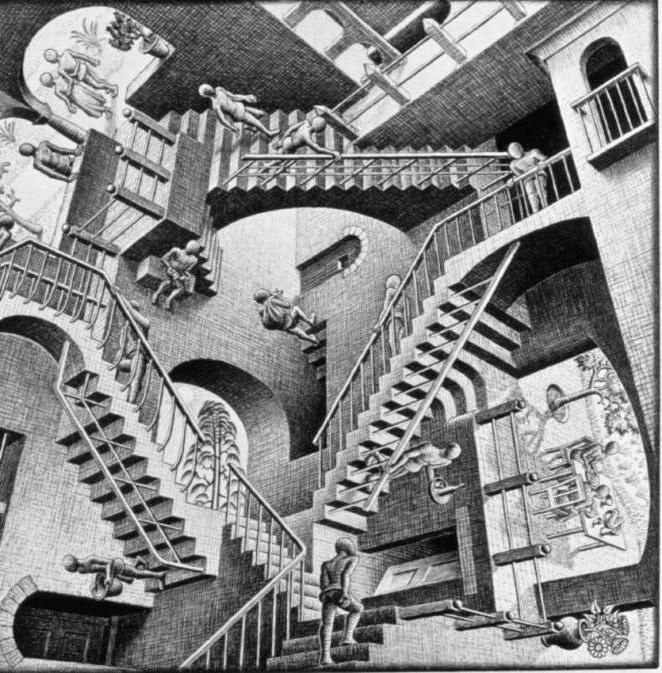In addition to artistic talent, Maurits Escher had a unique gift that he developed all his life, namely, the ability to look at the world and see it from an unusual angle of view. It is very rare to see unexpected things that have not been seen before by anyone who is familiar.
Creativity of Maurits Escher
In the family of engineer George Escher and his wife Sarah in 1898, the fifth son was born in the Netherlands, whom he was named Maurits. They lived in the Leeuwarden building, which now houses the Princesshofhof Museum. The family consisted of intellectuals and artists in the broad sense of the word. Escher's younger cousin was a composer, that is, a man sensitive to high harmony, built on exact mathematical principles.
Seriously, Maurits Escher studied with S. de Mesquite and consciously chose the work of an engraver, not an artist. As a basis, he tried various materials - linoleum, stone (specify that this material is considered only for prints, not prints), wood. If initially M. Escher created his works on contrasts of black and white, then later he will introduce color into his works.
Early work (1916-1922)
Traditional engravings are made either on linoleum or on wood. This is not the same Escher whose paintings are recognized immediately.
Italian period (1922-1935)
One of Escher's favorite books was Alice Through the Looking Glass. At the same time, he continues to study the art of the 15th century of northern European countries. The result of this was the 1935 lithograph, A Hand with a Mirror Sphere. She is also known as a self portrait. The hand that holds the spherical ball is drawn extremely realistically, so that all the lines of life and mind and each fold on the fingers are visible. Inside the ball, Escher's studio in Rome is depicted: the furniture distorted by the ball, the windows and ceiling curved by it. On the walls are viewed bookshelves, framed paintings. One of them depicts a doll of the Indonesian Puppet Theater. The engraver himself looks at the viewer directly, holding the sphere from the inside so that the thumb inside is in contact with the thumb from the outside. The little finger is likewise depicted.

The prerequisite for this work by Escher was 1934's Still Life with a Spherical Mirror. In this lithography, the engraver depicted himself at work. It is inside a rounded bottle with mirrored walls. It lies on newspapers, which, like all items, are placed on a closed book. Nearby is a metal bird with a human head. Both she and the newspapers are partially reflected inside the bottle.
In this work, all the gradations of black are studied: a deep black background, black shine of the bird metal, shades of black and gray inside the bottle. The portrait of the father with a magnifying glass in his hands was executed with meticulous precision, very realistic and with filial love. In the Italian period, Escher, whose paintings exactly follow nature, has not yet approached the study of three-dimensional space.
Mirror symmetry of objects
The master was greatly influenced by his acquaintance with the Arabic mosaics that he saw in the Alhambra and Cordoba, as well as with some geometric rules. All this was adopted by Escher, whose paintings immerse us in the world of symmetry. He takes the figures and makes a mosaic of them. One of the most significant is Reptiles (March 1943).
On lithography, the viewer sees a table. On it lies a drawing with a mosaic pattern of reptiles. In the right edge of the picture you can see how one of them begins to come to life and crawl out of a sheet of paper. She is just beginning to learn not a flat, but a three-dimensional world. Others, revived and regained volume, actively crawl along the book, the triangle, crawl onto the dodecahedron, release steam from the nostrils on it, crawl onto the paper and, closing the circle, become again a flat mosaic.
This image is paradoxical and with a touch of humor. Does it have a philosophical implication? Maybe. Indeed, on the table are four elements that make up the world. This is earth in a pot, fire enclosed in a box of matches, water that is poured into a glass, and air that a lizard exhales. On the table is a small book with Latin letters, which is confusing. Some mistook her for the book of Job. This is actually just a cigarette paper brand. In brackets, I must say that Escher was an inveterate smoker.

Of course, good work is Day and Night (1938). This thing also relates to the topic of symmetry. Escher, whose paintings by this time had not yet become popular, is very passionate about geometry. In this woodcut, the movement of light birds from left to right from the light toward the mirror-reflected night is initially seen. And only then their “negative” appears, as in the photo: black birds fly in the opposite direction in the white sky. And if you look in the opposite direction, it seems that the dark night is approaching white day. Randomness turns into orderliness, and vice versa. Such is the duality of perception of this engraving.
Mirror landscape
In December 1955, a new graphic work was published. Before this, Escher's landscapes were quite realistic, ordinary and familiar.
They were very bright, such as the “Snow” created in the Alps. The Three Worlds, like everything that Escher does, are surprising. This is a large pool or lake (as you imagine) in the fall. Fallen leaves from trees float on the surface of the water. The surface of the water is the first world. The second is in the depths of the lake, where we see big fish. She is not alone there, as it might seem. Crowns of trees, reflected in water, as in a mirror, seem to be the roots of trees invisible to the viewer. That which needs to be conceived is the third world.
Paradoxical worlds
Both Escher's paintings and engravings lead into the world of paradox. In them, the viewer is surprised and even stunned by the symmetry, and the prospects that lead the gaze to infinity do not leave indifferent. The master does not distinguish between art, mathematics and philosophy. They harmoniously flow into each other.
The theory of relativity in the work of Escher
Another lithography that Escher published in December 1953 is Relativity. She is executed in the style of surrealism. It depicts a world in which the normal laws of gravity do not apply. The entire architectural structure is in the center of an idyllic community. It has windows, doorways leading to a park superstructure. Most residents absolutely randomly go about their household needs. All figures are dressed in the same clothes. Their faceless heads are likened to bulbs. The structure of the building consists of seven stairs. Each of them can be used by people who are in different gravitational worlds. There are three sources of gravity in the picture. Simply put, they are all perpendicular to each other. Inside each gravity well, the usual physical laws apply.

This creates interesting effects. On the upper staircase, two residents, belonging to different sources of gravity, go in the same direction on one side of the staircase, but one of them descends and the other rises. On the other two stairs, residents use the same span, but from different sides. They go in one direction, but come in different places. The picture also depicts three parks that belong to different gravity wells. All but one door leads to basements below the parks. This adds a surreal effect to the picture. It is valuable both from an artistic and scientific point of view.
Artist Maurits Escher
In mathematics and philosophy, skillfully mastering the cutter and the drawing, skillfully beating the black color with all its gradations, the Dutch master drew inspiration. A poet in his soul, he verified harmony in his work, paraphrasing Pushkin, with algebra. M. Escher brilliantly combined art and science. The laws of physics, especially optical effects, were studied by him very deeply. His illusions are created mainly by the play of light and shadow. This is especially evident when creating volumetric geometric shapes, such as "Cuba". Escher's play of space appears in the Waterfall lithograph. Triple romantic rotational symmetries with snakes forming a circle are very romantic (1969).

In general, with respect to Escher's creations, it is rather necessary to use the phrase “logical riddles”. He could not hold imagination and knowledge, and with every picture he could put a man in a dead end. But, looking at his works, you find iron logic, harmony and the laws by which they are built.